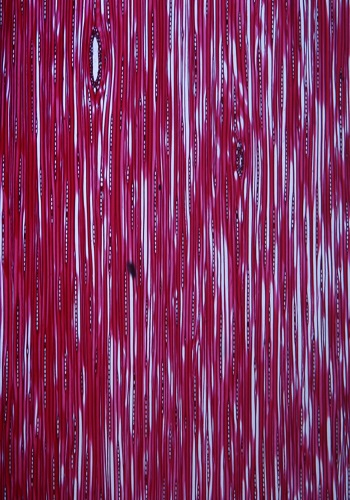This tree is native to the Himalayas of the sub-continent including Pakistan, Afghanistan and India. In Pakistan it is found at high elevations in Azad Kashmir, Murree Hills, Hazara, Swat, Dir, Tirah and Chitral.
The heartwood is distinct from sapwood. The sapwood is white in color while heartwood is light yellowish-brown having characteristic resinous odor and oily feel. The wood is straight-grained, medium-fine with somewhat uneven-texture.
The growth rings are distinct, delineated by a narrow, somewhat darker band of denser summerwood and are 7-30 per inch. The tracheids are medium fine, 1.4-4.7 mm in length, 40-53 µ in diameter with 3-4 µ wall-thickness in springwood and 6-10µ in summerwood. The parenchyma extremely sparse, restricted to outer faces of summerwood. The rays are not distinct with the naked eye, very fine 5-9/ mm, 17-23µ wide and upto 700 µ in height. The resin canals of normal type wanting, however traumatic canals are frequently present.
 |
 |
 |
| Cross view of Deodar wood | Tangential view of Deodar wood | Radial view of Deodar wood |
An important structural timber suitable for construction, railway sleepers, carriages and wagon work. The wood can also be used in door making, beams, floor board, window frames, light furniture and ordinance boxes..
1. Pearson, R.S and H.P. Brown.1932. Commercial Timbers of India.pp 1046-1051.
2. Sheikh, M.I.1993. Trees of Pakistan. Pakistan Forest Institute, Peshawar. pp-51. 3. Siddiqui, K.M., M. Ayaz and I. Mahmood.1996. Properties and Uses of Pakistani Timbers. Pakistan Forest Institute, Peshawar.pp23-25.